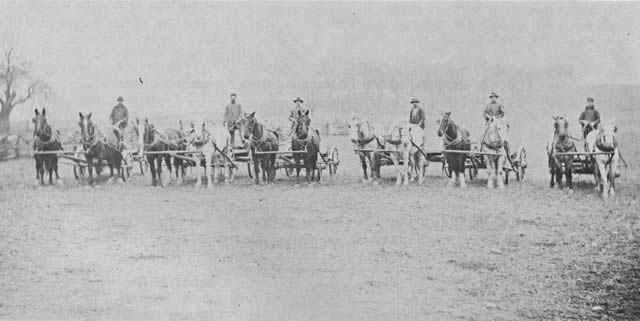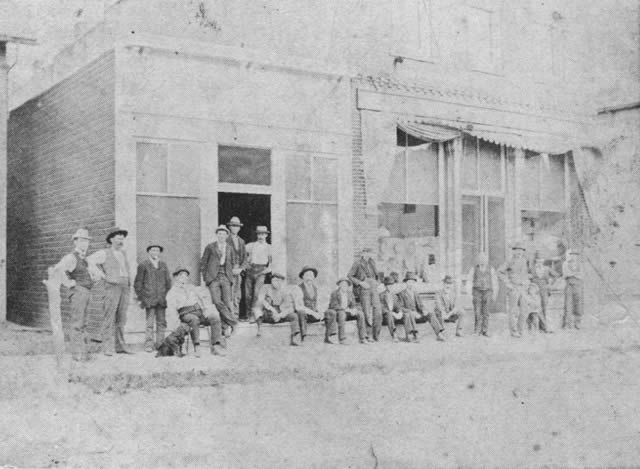Volume 4, Number 5 - Fall 1971
School Placenames in Ozark County
By P. R. Pfister
School Placenames in Ozark County By P. R. Pfister
Education and its institutions played an important part in the early pioneer’s lives. Little backwoods schools and the names for them "just sorta growed up like an ungrazed pasture." Improved roads and consolidation have wiped out these schools. The buildings themselves were often used as barns, were moved or converted into homes, or simply allowed to decay. The one room schools have vanished and their names are nothing but a faded memory to the few remaining people who learned the three R’s there. Finding how and why these schools were named is a difficult but interesting study.
One of the easiest and probably most natural ways of choosing a school’s name was for the early settlers to transfer a name already in existence—a name from a church, township, or post office. Ozark County has many of these transfer names because it is a relatively old county and has had many settlements and post offices which have disappeared from the face of the land. Very often residents have forgotten the existence of these old stores and post offices. There is a total of 38 of these transfer names. All of the school names are listed at the end of this article, though only several of the more interesting ones are discussed.
Dawt School was named for the post office established in 1904, but no one seems to know how the post office got its name; Locust also comes from a post office which got its name from the fact that the store and post office were encircled by locust trees. Nebraska as a school name journeyed all the way from the cornhusker state. Toledo comes from the township which was named for a post office established in 1913 which in turn had been named for Toledo, Ohio. Nottinghill’s name traveled much farther though. The school was named after the community which in turn had gotten its name in 1894 from Samuel Baker, an Englishman, who named it for Nottinghill in London.
Early settlers found that Ozark County abounded with springs and streams. Because schools were often built near a good water source- a clear spring or a "year-round branch" -they often took on the names of creeks and springs. Examples are Barren Fork, Long Run, Otter Creek, and Brush Creek.
Hollows, balds, and knobs are also important in the naming of early schools. Ozark County was explored early; however, it was not until many years later that it was permanently settled. Because of the rocky character of its hills, the infertile nature of much of its soil and its general lack of vegetation, it received very few settlers. Hunting and fishing were usually good, but few people wanted to make the area their permanent home. As a result, the population was greatly scattered since only the bottoms could be farmed with any great success. This all resulted in very scattered schools which took on the name of the nearby bald, hollow, or ridge. These natural features were the settlers’ signposts in an area that lacked a developed road system. Directions were given with knobs, ridges, bluffs, and hollows serving as roadsigns. Every hill or knoll had a local name, though maps generally do not show them because the names changed with time and settlers. Thus Smith Hollow, named for a hunter who had a temporary camp there might become Wells Hollow for a family that settled by the spring there after the hunter had gone.
Many times the schools were erected in a central location in order to make it convenient for the students. This often meant that it was built on relatively undesirable land or in a lonely, isolated spot. In such cases they were often named for the nearest neighbor or for some environmental attribute— perhaps a tall cedar tree or a ledge of sandstone. Ozark County school names of an environmental nature include the common Bald and the poetic Evening Shade as well as such names as Brushy Knob and Cedar Tree. Others are Mineral Point, Oak Dale, Red Oak, Stony Point, and Pond Hill.
The names of important national figures are often attached to schools, but in the Ozarks, the settlers tended to name their schools after local people. At a time when an education was a rare and valued commodity, the land for a school would often be donated by one of the men in the community. Schools with family names can be
[7]
traced to just such a circumstance. Many times, however, the land had to be bought if the school was not lucky enough to receive a gift of land. In such cases, the school name might be that of the former owner of the land.
Another common practice was to name the school after one of its directors. Usually the most influential or wealthiest member had his name attached to the new school. Such a choice was difficult and often much bickering and ill feelings would result over such a small chore as choosing a name. (In Taney County, one school settled such a dispute by calling itself Three Johns because three of its directors were named John.) Ozark County has twelve schools named after local people including Bushong, Salle, Luna, and Bratcher. A man by the name of Lilly gave his name to a ridge as well as the land for Lilly Ridge
That the hills people had a true feeling for the beauty and majesty of the mountains is revealed in the choice of their names. Evening Shade, Fair View, and Lone Pilgrim show a keen appreciation for the landscape or the mood evoked by a beautiful view. The names of approbation are much more numerous than the names of disapprobation. Ozark County has Oakmound and Pleasant Grove and Pleasant Hill, but only one name that jars the listener’s ear—Mud Point. It is interesting to note, however, that both Pleasant Hill and Pleasant Grove have second names attached to them. Pleasant Grove is also known as Hog Danger because a few of that community’s residents were prone to steal hogs or change the marking notches on hogs’ ears so that they couldn’t be claimed by the true owners. Pleasant Hill is also known as Seedtick, possibly because of an abundance of the pesky parasites in that area.
Humorous names are by far the most interesting in a study of placenames. Several Ozark County school placenames reflect the joy that is evident in a joke. In addition to Hog Danger and Seedtick, the county had a Needmore and an Eighty-Eight named for the
number of the school district and for its alliterative quality. Barefoot was so named because its scholars dressed that way. Douglas County had a school named New Jail that no doubt reflected the sentiment of some of its students during the hot days of autumn, but Ozark County had a school that every student dreams of attending. It was called Never Fail.
SCHOOL PLACENAMES
TOTAL NAMES—(79)
1. TRANSFERRED NAMES (38): a. From Towns, Townships, Post Offices (14): Bakersfield, Dawt, Dora, Dugginsville, Gainesville, Hammond, Howard Ridge, Igo, Isabella, Lilly Ridge, Locust, Lutie, Mammoth, Nebraska, Noble, Nottinghill, Pontiac, Romance, Souder, Theodosia, Thornfield, Toledo, Udall, Wasola. b. From Streams and Creeks and Springs (7): Barren Fork, Brush Creek, Little Creek, Long Run, Lower Brixey, Otter Creek, Upper Brixey. From Churches (7): Mt. Lebanon, Mt. Olive, New Hope, Smith Chapel, Valley Star, Shiloh, Salem.
2. NAMES FOR PERSONS (all local) (11): Bratcher, Bushong, Colvin, Collins, Dobbs, Fay, Liner, Lottie Hollow, Luna, Odom, Salle.
3. ENVIRONMENTAL NAMES (21): a. Situation and Description (17): Bald, Brushy Knob, Decar Tree, Center Point, Mineral Point, North View, Oak Dale, Oakmound, Pine Valley, Pine View, Pond Hill, Red Oak, Sand Ridge, Stony Point, Evening Shade, High View, Lone Pilgrim. b. Approbation and Disapprobation (4): Fair View, Mud Point, Pleasant Grove (Hog Danger), Pleasant Hill (Seedtick).
4. SUBJECTIVE NAMES (9): a. Ideals and Emblems (6) Banner, Charity, Council Grove, Eighty-Eight, Never Fail, White Star. b. Bibical Names (1): Idumea. c. Humorous Names (2): Needmore, Barefoot.
[8]

James F. Robertson, Second from left.

At Taneyville
The photographs on this page were contributed by Mildred Robertson Derr from her mother's collection.
Abner Garrison was born in Grayson county Va, October 15, 1812. He moved to Allen County, Ohio, with his parents, when two years old. He was educated and married in Ohio, and moved to southwest Missouri in 1812. He is a farmer, and has held a county office ever since the organization of Douglas County, having been twelve times a candidate and every time successful. He has been justice of the peace, assessor, sheriff, county and circuit clerk, and a member of the 29th Assembly.
—Commonwealth of Missouri, 1877
Jordon M. Haw Orth was born in Park County, Indiana, April 3, 1835. In 1836 his parents moved to Wilson County, Tennesse, where he was educated at a comm school. At the age of eighteen he moved with his parents to Taney County, Missouri. Three years later he moved to Bullard County Kentucky, where he married in June 1857. He remained on a farm in KentucKy until 1865, when he removed to Taney County, where he has since resided. He was slected to the 29th General Assembly as a Democrat.
—Commonwealth of Missouri, 1877
[9]
This volume: Next Article | Table of Contents | Other Issues
Other Volumes | Keyword Search | White River Valley Quarterly Home | Local History Home
Copyright © White River Valley Historical Quarterly

